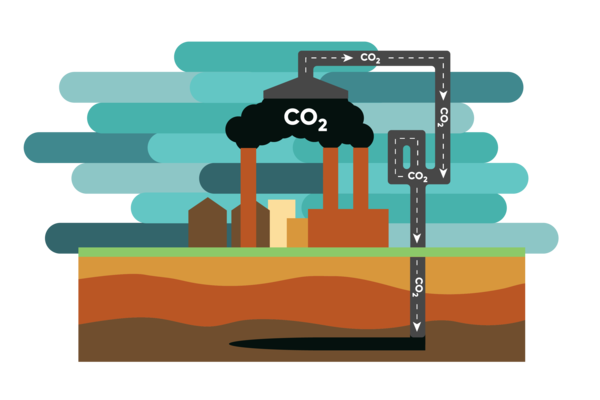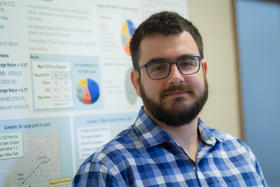
by Brian Grimmett, Kansas News Service
Wichita, Kansas — Large industrial operations — think electrical power plants, oil refineries, ethanol facilities —cough carbon dioxide into the atmosphere by the ton. That, in turn, warms the planet.
But now some researchers think Kansas could be a good place to pump the gas underground rather than up in the air.
Carbon dioxide is all around us. Plants use it for food. Humans exhale it. It’s used in dry ice and to make your soda fizzy.
But it’s produced in serious, problematic quantities when we burn fossil fuels — every time we jump in a car and to generate the majority of the electricity we use.
When we do that, we’re taking carbon that was once stored in the ground and putting it into the atmosphere as carbon dioxide, or CO2.
CO2 is a greenhouse gas. Greenhouse gases help trap heat in the atmosphere. Climate scientists predict that if we keep producing them at current rates, annual average global temperatures will rise by nine degrees by the end of this century. Weather patterns will become ever more severe, the oceans will rise.
To prevent some of the catastrophes that would cause, researchers want to stash CO2 emissions back in the ground.
With funding from the U.S. Department of Energy’s CarbonSAFE program, researchers from the Kansas Geological Survey, environmental policy groups, lawyers and oil and gas companies spent the last three years investigating the feasibility of carbon capture and storage in Kansas.
“No matter how you slice it,” said Eugene Holubnyak, a petroleum engineer leading the project at the Kansas Geological Survey, “we’re centrally located and I think we have all the necessary components that need to be in place to be a hub for distributing CO2.”

(Illustration by Chrysta Henthorne, Kansas News Service)
The research first looked at the potential of capturing CO2 emissions from Westar’s Jeffrey Energy Center, a coal-fired power plant located northwest of Topeka. It’s one of the largest emitters of carbon dioxide in the country.
The project would work like this.
First, capture the CO2 straight from the exhaust stacks of the power plant. Then, compress the gas into a liquid. It would then be put it in a pipeline and sent to southwestern Kansas where it would be pumped deep into the ground.
In some cases, it would be put into what’s known as a saline aquifer — essentially a natural underground storage tank.
In other cases, it would be used for something called enhanced oil recovery. That means injecting CO2 into the ground on one side of a deposit to push hard-to-reach oil and gas toward a well on the other side.
The researchers discovered that, at this point, that plan would be too expensive. Even with recently approved tax incentives aimed at jumpstarting carbon capture projects, it would cost Jeffrey Energy Center far more to capture and compress than it could make selling the CO2.
A possibility that might be more economically tempting would capture CO2 from a network of ethanol plants across the Midwest.
That’s because unlike the byproduct of burning coal, which contains multiple chemicals — pollutants that would have to be separated before you pump anything into the ground — ethanol coughs up relatively untainted carbon dioxide.
“The challenge is that, relative to the size of a power plant, ethanol plants are pretty small,” said Brendan Jordan, who worked on the project for the Great Plains Institute, a non-profit that wants to transform the country’s energy systems.
Under that scenario, size would matter. To make the same kind of impact that capturing CO2 from a power plant would have, ethanol plants from all over the Midwest would need to be connected through a regional pipeline.
Jordan said that kind of network would be a start until the cost of capturing power plant CO2 and other industrial sources drops dramatically.
And it might rally a range of people often at odds with each other.
Environmentalists support it because it could help curb climate change. Ethanol plants like it because it opens up a new revenue stream selling CO2 to oil and gas companies. The oil and gas industry is on board because it’s looking for a cheap, consistent source of CO2 to use in enhanced oil recovery.

That kind of broad support makes Jordan optimistic a commercial project could launch in the next five to 10 years.
“The problem we have in the Midwest is a mismatch between where a lot of the ethanol plants are and where the appropriate geology is,” Jordan said.
Kansas is right in the middle of that equation. Any major pipeline project would have to run through the state — allowing both producers and consumers of CO2 to easily connect.
Andrew Duguid is a lead researcher with Batelle, one of the nation’s largest research and development companies. He’s working on the next phase of the Midwest CarbonSAFE project that is looking toward actual development. He said Kansas will play a key role.
“You’ve got the right geology to do saline projects and you’ve got a lot of oil and gas,” Duguid said. “Those fields are at the right depths and have the right properties to do enhanced oil recovery.”
But some environmentalists worry about the unintended consequences of the tax incentives that make any of this profitable enough for companies to try. Particularly since it might just enable more oil drilling.
“Is it a good thing to make it cheaper to produce a barrel of oil from those facilities?” said Natural Resources Defense Council climate policy director David Hawkins. “Not if we’re trying to reduce our dependence on oil.”
Hawkins argues carbon capture and storage isn’t a grand solution for eliminating all fossil fuel emissions, but rather one of many tools to reduce their impact.
Even if carbon capture makes it easier to drill for, and burn, oil, Hawkins said it could ultimately offset the fossil fuel use it would make easier.
For now, at least, it’s all still an idea. Researchers and industry professionals are working to make it a reality. But a future with large-scale carbon capture, pipelines and storage projects still largely depends on potential regulatory changes, tax incentives, and the economy as a whole.
So when will the first project get built in Kansas?
“Bold statement: five years,” KGS petroleum engineer Eugene Holubnyak said. “If not in this time it’s probably never going to happen.”
Brian Grimmett reports on the environment, energy and natural resources for KMUW in Wichita and the Kansas News Service. You can follow him on Twitter @briangrimmett or email him at grimmett (at) kmuw (dot) org. The Kansas News Service is a collaboration of KCUR, Kansas Public Radio, KMUW and High Plains Public Radio focused on the health and well-being of Kansans, their communities and civic life.
Kansas News Service stories and photos may be republished by news media at no cost with proper attribution and a link to ksnewsservice.org.
See more at https://www.kcur.org/post/what-if-we-belched-less-co2-atmosphere-stashing-it-under-kansas-0
